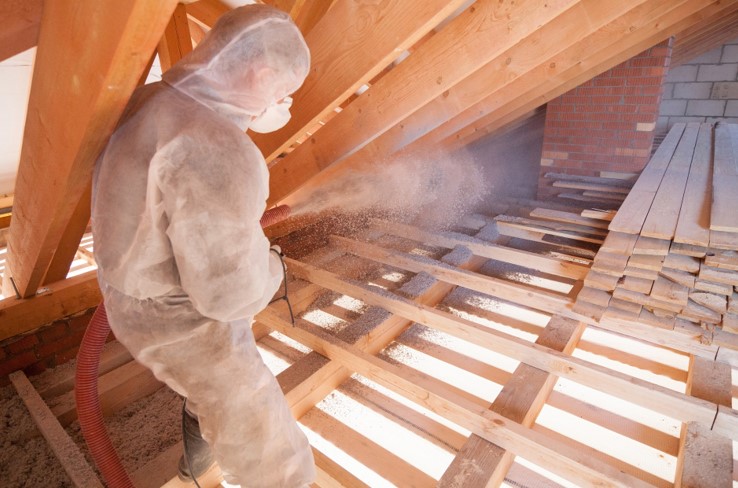When deciding on attic insulation, the “best” option depends on what you value most—performance, cost, or ease of installation. Insulating your attic is a key step in improving your home’s energy efficiency, lowering utility bills, and maintaining a comfortable living space. To help you make an informed decision, let’s explore the four most common types of attic insulation: fiberglass batts, cellulose, loose-fill fiberglass, and spray foam. We’ll also discuss their pros, cons, and ideal applications.
Common Types of Attic Insulation
1. Fiberglass Batts
Fiberglass batts are pre-cut insulation sheets made from fine glass fibers. They’re a go-to option for DIYers because they’re readily available, easy to transport, and simple to install.
Pros:
- Convenient for small projects or quick fixes.
- Affordable and widely available in most home improvement stores.
Cons:
- Poor insulation performance compared to other materials.
- Difficult to achieve a snug fit around beams, wires, and vents, leading to gaps and energy loss.
- Can settle or sag over time, reducing effectiveness.
Fiberglass batts have an R-value of approximately 2.9 to 3.8 per inch, which is decent but falls short in colder climates where higher insulation is needed. If improperly installed, they can compromise energy efficiency.
2. Cellulose
Made from recycled paper treated with boric acid for fire resistance and pest control, cellulose is an eco-friendly and effective insulation option. It’s commonly installed as loose-fill using a blower, which ensures even distribution.
Pros:
- Higher R-value (around 3.5 per inch) than fiberglass.
- Dense material helps reduce air movement, minimizing heat loss.
- Eco-friendly, as it’s made from recycled materials.
- Offers good fire and pest resistance due to chemical treatments.
Cons:
- Creates a lot of dust during installation, requiring protective gear.
- Requires a blower for installation, which may not be ideal for DIY projects.
- May settle over time, reducing its effectiveness unless properly installed.
When applied professionally, wet-spray cellulose can achieve even better results by reducing dust and slightly increasing its insulation value. This option is great for homeowners looking for a sustainable, cost-effective solution that performs well in most climates.
3. Loose-Fill Fiberglass
Loose-fill fiberglass is another common option, especially in newly constructed homes. It consists of tiny fibers blown into the attic to fill gaps and create an insulating layer.
Pros:
- Lightweight and ideal for hard-to-reach areas.
- Improved formulations have reduced itchiness and respiratory irritation.
- Cost-effective for large projects and easy to install with the right equipment.
Cons:
- R-value of about 2.5 per inch, which is lower than cellulose.
- Can lose effectiveness in extremely cold temperatures due to convection, though modern formulations have improved this issue.
- Requires a blower for installation, making it less DIY-friendly.
Loose-fill fiberglass is a versatile option, especially when installed by professionals who can ensure proper coverage and depth.
4. Spray Foam
Spray foam is the gold standard in insulation, offering the best performance in terms of sealing air leaks and providing thermal resistance. It comes in two types: closed-cell and open-cell.
- Closed-cell spray foam: Dense and rigid, with an R-value of around 6.5 per inch. It also acts as a moisture barrier.
- Open-cell spray foam: Softer and less dense, with an R-value of approximately 3.6 per inch.
Pros:
- Creates an air-tight seal, eliminating drafts and heat loss.
- Prevents moisture buildup, which can lead to mold and structural damage.
- Provides the highest R-value per inch, making it ideal for tight spaces.
Cons:
- Expensive upfront cost compared to other materials.
- Requires professional installation, as improper application can lead to issues.
- Some people have concerns about off-gassing, so research is essential.
Spray foam is a long-term investment that pays off in energy savings and durability. It’s best suited for homes in extreme climates or where energy efficiency is a top priority.
How to Choose the Best Attic Insulation
When selecting attic insulation, consider the following factors:
- Performance (R-Value)
- Higher R-values provide better thermal resistance, making them essential in colder climates.
- Spray foam and cellulose offer the highest R-values per inch, making them ideal for maximum energy efficiency.
- Cost
- Fiberglass batts and loose-fill fiberglass are more budget-friendly but may not perform as well as cellulose or spray foam.
- Spray foam has a higher upfront cost but offers long-term savings through energy efficiency.
- Ease of Installation
- Fiberglass batts are the easiest for DIY installation.
- Cellulose and loose-fill fiberglass require a blower for proper application, while spray foam should always be installed by professionals.
- Durability
- Spray foam and cellulose are less likely to degrade over time compared to fiberglass.
- Properly installed cellulose resists settling and remains effective for years.
- Environmental Impact
- Cellulose is the most eco-friendly option due to its recycled content.
- Spray foam has a higher carbon footprint but provides long-term energy savings.
Final Thoughts
The best attic insulation depends on your specific needs and priorities. If you’re looking for affordability and ease of installation, fiberglass batts might be the right choice. For eco-friendliness and solid performance, cellulose is a great option. If you want the highest R-value and long-term savings, spray foam is worth the investment.
Before making a decision, consider consulting a professional to assess your attic’s condition, climate, and energy efficiency goals. Investing in the right insulation now will save you money on energy bills and improve your home’s comfort for years to come.
